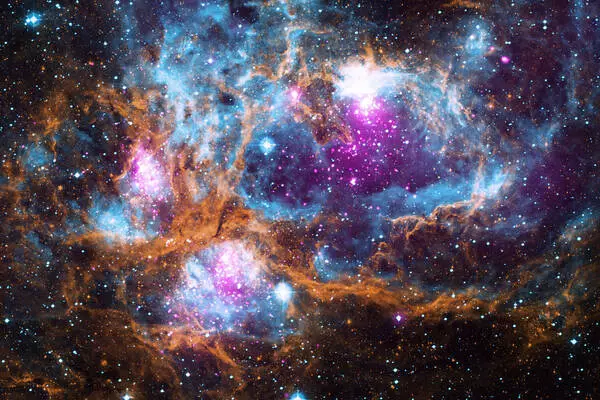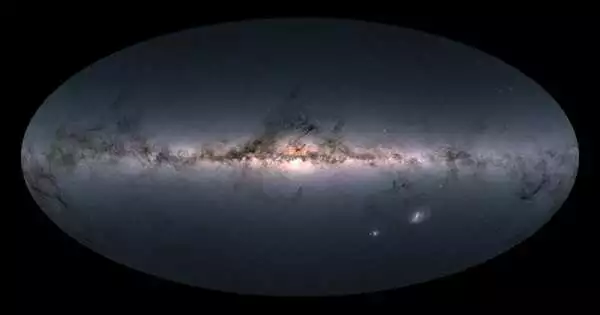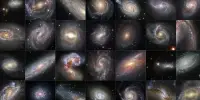The inner region of a galaxy is where most of the galaxy’s stars are located. It is also where the galaxy’s central supermassive black hole is found, if it has one. The inner region is usually more densely packed with stars and gas than the outer region, and is often referred to as the galactic bulge. The dust in this region can be difficult to observe due to the glare of the stars and the fact that dust absorbs and blocks light, making it appear dark.
However, with the use of specialized telescopes and other instruments, it is possible to study the dust in the inner region of distant galaxies and learn more about the conditions and processes taking place there.
An international team of scientists has directly observed the long-desired innermost dusty ring surrounding a supermassive black hole, at a right angle to its emerging jet. Such a structure was thought to exist in the nuclei of galaxies but had been difficult to observe directly due to interfering material.
The inner disk is now being detected with the highest spatial resolution in infrared wavelengths ever achieved for an extragalactic object. The new finding was recently published in The Astrophysical Journal.
“This is a very exciting step forward to view the inner region of a distant galaxy with such fine detail,” said Gail Schaefer, Associate Director of the Center for High Angular Resolution Astronomy (CHARA) Array.
Every large galaxy is thought to contain a supermassive black hole. The gas forms a hot and bright disk-like structure as material in the surrounding region is drawn toward the center. In some cases, a jet emerges from the black hole’s vicinity in a direction perpendicular to the disk. However, because it is too small to be captured by conventional telescopes, this flat structure, which is essentially the ‘engine’ of this active supermassive black hole system, has never been directly observed.
This greatly increased the injection rate of the light, compensating for the relatively small collecting mirror to observe the extragalactic target, which is much fainter than the stellar targets typically observed in our Galaxy.
Matt Anderson
One way to approach this key structure is to directly see an outer ‘dusty ring’ – interstellar gas contains dust grains, tiny solid particles made of heavy elements, which can only survive in the outer region where the temperature is low enough (< ~1500K – otherwise metals evaporate). The heated dust emits thermal infrared radiation and thus would look like an outer ring around the black hole if the central system indeed has a flat structure. The detection of its structure would be a key step to delineating how the central engine works.
Attempts to see this structure from the edges are difficult because the system is obscured by the same dust acting as a light absorber. Instead, the team focused on a system with a face-on view, the brightest such object in the nearby universe, in the new investigation. However, the detection required very high spatial resolution in the infrared wavelengths, as well as a large array of telescopes configured to observe objects at various orientations.
The only facility that meets both of these requirements is the Georgia State University CHARA Array interferometer at Mount Wilson Observatory in California. The Array is made up of six telescopes, each with a one-meter-diameter mirror, that work together to achieve the spatial resolution of a much larger telescope. While each individual telescope is small, the array layout is designed to observe objects from various angles and with large distances between telescopes. This results in an extremely high spatial resolution capability. In infrared wavelengths, the CHARA Array has the sharpest eyes in the world.

With the CHARA Array, the team finally detected the dusty ring, at a right angle to the emerging jet in the center of the galaxy called NGC 4151. “We’ve been hoping to see this structure in a bare nucleus object for a long, long time,” says Makoto Kishimoto, principal investigator of the project at Kyoto Sangyo University. A big boost was that each telescope has recently added a new system called “adaptive optics.”
“This greatly increased the injection rate of the light, compensating for the relatively small collecting mirror to observe the extragalactic target, which is much fainter than the stellar targets typically observed in our Galaxy,” says Matt Anderson, a postdoctoral researcher at the CHARA Array who played a critical role in the observations.
For nearly four decades, researchers in the field have believed that this dusty ring holds the key to understanding various characteristics of accreting supermassive black hole systems. The properties we observe differ depending on whether we have an obscured, edge-on view or a clear, face-on view of the active galaxy’s nucleus. This model is validated by the discovery of this ring-like structure.
Furthermore, the detection is most likely more than just an indication of a flat structure. Additional research has revealed that the structure observed at slightly longer infrared wavelengths, corresponding to an even larger outer region, appears to be elongated along the jet rather than at a right angle to it. This has been interpreted as a dusty wind being blown out in the direction of the jet. The current discovery that the inner structure appears flat and perpendicular to the jet is a crucial link to the windy structure and its interaction with the rest of the galaxy surrounding the active black hole system.
These ground-breaking findings determined the size and orientation of the dusty disk. The team is working to get an even more detailed image of the central region by building a new instrument at the CHARA Array that can see deeper into space and resolve finer scale structure of the source.
















